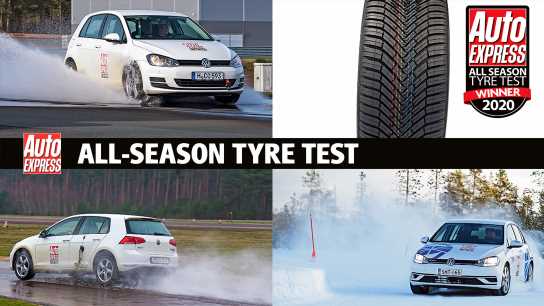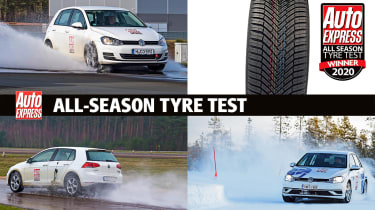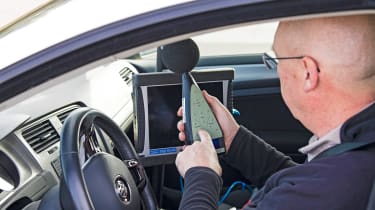The UK’s variable weather makes it a prime market for all-season tyres, but which set is best? We test them back-to-back.
- Introduction
- Vredestein Quatrac Pro – 6th
- Cooper Discoverer All Season – 5th
- Michelin CrossClimate+ – 4th
- Hankook Kinergy 4S2 – 3rd
- Goodyear Vector 4Seasons Gen-3 – 2nd
- Continental AllSeasonContact – 1st
- Verdict & Results by category
Booming sales mean that all-season tyres are not just the focus for drivers looking to deal with extreme conditions, but also producers, who are updating or expanding their ranges to meet demand. The pace of change means that several new tyres have been launched since our test started in early March, too.
Our all-season test faced the same challenges as our winter one, so although our snow and wet tests were completed before the pandemic struck Europe, quarantine requirements meant we had to forego our usual dry handling assessment. However, while this has a greater role in all-season tyres than for winter designs, it’s still not a key performance area. To ensure we still had a set of useful results, proving ground staff completed dry braking and cabin noise tests on our behalf.
Tyre reviews: best car tyres 2020
We return to the popular 225/45 R17 size here, and bought samples to ensure we tested what you can buy. Goodyear and Hankook supplied their samples, but we later ensured these were the same as those on sale by comparing wet braking results with purchased sets.
There’s been a change of focus in some all-season tyres, with a greater emphasis on wet and dry performance at the expense of snow grip. Continental, with its new generation of all-season tyres, took the win when we last tested this size. Will it prevail again, or will the more winter-focused tyres succeed?
What we tested
We bought what the maker specified in terms of speed and weight ratings. Speed ratings covered V (up to 150mph) to Y (up to 186mph). We’ve included each tyre’s EU label, too, with A being the best for economy (RR) and wet grip (WG). The pass-by noise figure (N) is in decibels, and the lower it is, the better.
Tyre ratings | |||||
Tyre | Load | Speed | Economy / Rolling Resistance (RR) | Wet grip (WG) | Noise (N – decibels) |
Continental AllSeasonContact | 94 | V | C | B | 72 |
Cooper Discoverer All Season | 94 | W | C | B | 70 |
Goodyear Vector 4Seasons Gen-3 | 94 | W | C | B | 70 |
Hankook Kinergy 4S2 | 94 | W | C | B | 70 |
Michelin CrossClimate+ | 94 | W | C | B | 69 |
Vredestein Quatrac Pro | 94 | Y | E | B | 71 |
How we tested the tyres
Snow
We broke new ground this year with our winter testing because, despite returning to Ivalo in northern Finland once again, we were at a new facility – Hankook’s Technotrac. It’s next door to the Test World facility we used with the Korean producer in 2016, and features two handling circuits plus areas for straight-line tests.
We used the 1,200m flat handling track, which combined long sweeps that allowed the tyre’s balance to be assessed, with tighter sections testing lateral grip and traction on lock. Average lap times provided the result. Traction and braking were combined into one test, timing how long it took to accelerate from 12-31mph and then the distance taken to slow to 6mph. An average of several runs was used.
Wet
It was back to the familiar surroundings of the Contidrom near Hanover, Germany, for wet testing. No need to learn the handling track here because we’ve completed hundreds of laps around the circuit, which weaves its way through trees inside the banked oval. Average times from a series of laps formed the result.
On the way to the handling track we timed 10 laps around the wet circle, which provided a measure of pure lateral wet grip. The site’s rail system ensured that every stop in the braking test was done on same piece of tarmac. We measured the distance taken to stop from 50mph, and did a series of runs to get a result.
The rail was used again for straight aquaplaning, where the car was accelerated with one wheel in 9mm of water. The speed where the tyre in the water was spinning 15 per cent faster than the other – the point where control is lost – was measured over multiple runs. The water depth dropped to 6mm for the lateral test, where the car was driven at increasing speeds around a large tarmac circle with one section flooded. Lateral g-force was measured until all grip was lost through the flooded track.
Dry
No handling tests this year thanks to travel restrictions, but proving ground staff completed braking, measuring the distance taken to stop from 62mph. An average of stops was used to get the result.
Rolling resistance Key for fuel economy, this measures, to industry standards, the force required to roll a weighted tyre. To see a one per cent change in fuel consumption requires around a five per cent movement in rolling resistance.
Noise
Unlike the EU label, which measures pass-by noise using specially sealed cars to focus on what the tyre generates, our test focused on cabin levels. This year it was measured at 62mph on smooth tarmac.
Price
We used online tyre retailer and multiple Auto Express test winner Black Circles to provide our fully fitted prices. The figures are what it charged at the time of writing; if it does not stock a tyre, the cost is what it would charge. Price plays a small role in the overall ranking, because our test prioritises performance and safety.
Best winter tyres 2020: tyre brands reviewed and UK prices compared
Picking a winner
To reflect the UK’s weather, snow performance was 10 per cent of the overall result, with wet representing 50 per cent and the remainder split between the other tests.
Essentially we converted the results into percentages. These were then added together, with weighting in each category designed to ensure tests with a wide performance difference did not have undue influence on the result. We also focused on the safety-critical tests – braking and handling. In each tyre’s results, the winner was rated at 100 per cent and the rivals ranked relative to that benchmark.
More all-season tyre reviews
- Goodyear Vector 4 Seasons Gen 2 (2019 all-season test)
- Nokian Weatherproof (2019 all-season test)
- Bridgestone Weather control (2019 all-season test)
- Falken Euro all-season (2019 all-season test)
- Nankang All Season (2019 all-season test)
Best winter cars
| • Hot new SUVs coming soon | • Best SUVs to buy now |
| • Best crossovers to buy now | • Best small 4x4s to buy now |
Get ready for winter on the roads
| • Winter tyre test | • All-season tyre test |
| • Choosing the best tyres for your car | • Snow chains in the UK: do you need them? |
| • Winter car checklist and best buys | • The best winter driving courses |
| • How to store your car over winter | • How to avoid a flat car battery |
| • The world’s coldest roads | • Preparing your car for winter |
Top tips for winter driving
| • What is all-wheel drive? | • Winter driving tips |
| • 10 winter driving myths busted | • How to drive in rain and floods |
| • How to drive on ice | • How to drive in snow |
| • How to control skids | • How to use ABS brakes |
| • What is ESC or ESP? | • How to jump start your car |
Continue Reading
- 1Introduction – currently readingThe UK’s variable weather makes it a prime market for all-season tyres, but which set is best? We test them back-to-back.
- 2Vredestein Quatrac Pro – 6thThe Vredestein Quatrac Pro takes sixth place in our 2020 all-season tyre test
- 3Cooper Discoverer All Season – 5thThe Cooper Discoverer All Season tyre places 5th in our 2020 all-season tyre test
- 4Michelin CrossClimate+ – 4thThe Michelin CrossClimate+ was the 4th placed tyre in the 2020 All-Season Tyre Test 2020
- 5Hankook Kinergy 4S2 – 3rd3rd place in our 2020 All-Season Tyre Test goes to the Hankook Kinergy 4S2
- 6Goodyear Vector 4Seasons Gen-3 – 2ndThe Goodyear Vector 4Seasons Gen-3 comes second in the 2020 All-Season Tyre Test
- 7Continental AllSeasonContact – 1stThe Continental All Season Contact is the winner of our 2020 All-Season Tyre Test
- 8Verdict & Results by categoryTables show which all-season tyres performed well where, and how they compare
Source: Read Full Article




 Tyre reviews: best car tyres 2020
Tyre reviews: best car tyres 2020

 Best winter tyres 2020: tyre brands reviewed and UK prices compared
Best winter tyres 2020: tyre brands reviewed and UK prices compared